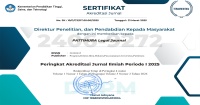SUBMIT YOUR ARTICLE
ADDITIONAL MENU
PELA CERTIFICATE

PELA SCOPUS CITEDNESS
PELA JOURNAL TEMPLATE
PELA INDEXED



PELA OPEN ACCESS
PATTIMURA Legal Journal is an open access journal, so articles are freely available to the readers.

PELA TOOLS
PELA ISSN
PELA VISITORS
PELA LOCATION
















